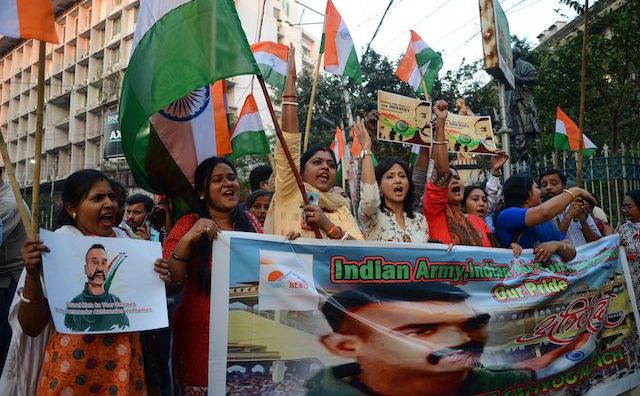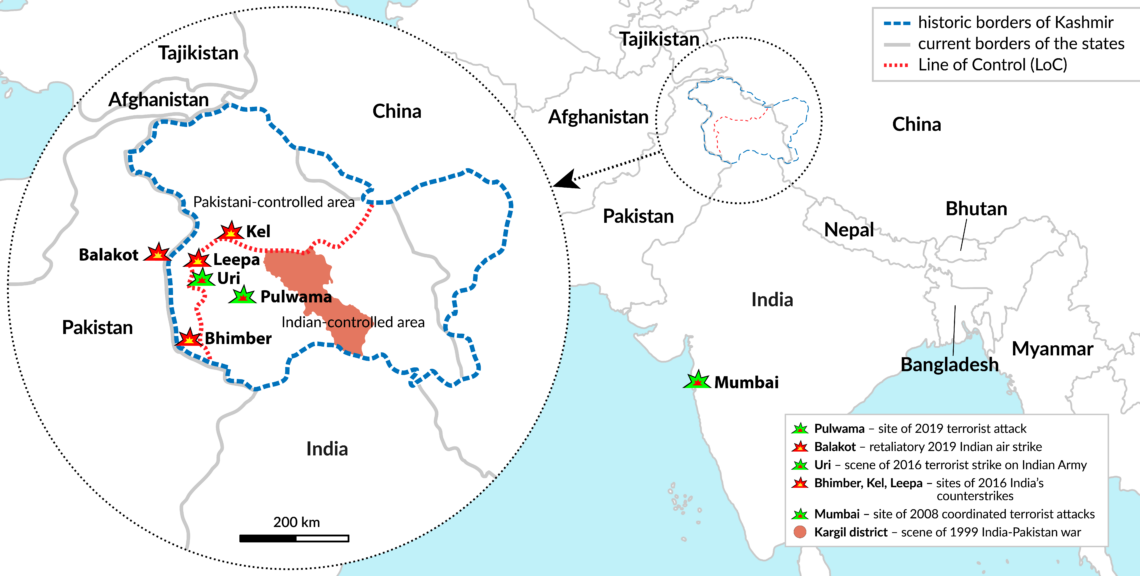The Kashmir crisis exerts pressure on both the U.S. and China
The conflict over Kashmir has led to three wars and countless skirmishes between India and Pakistan. As tensions are building up again in the region, outside powers cooperate to prevent the worst. Washington’s and Beijing’s influence over the decision-making process of the two nuclear weapons-armed states may be gradually waning.

In a nutshell
- India radically hardened its responses to Pakistani-harbored terrorist groups attacking targets in Kashmir and beyond
- The U.S. gradually withdraws from its pro-Pakistan stance while its relations with India are becoming closer
- China values the benefits of close cooperation with Pakistan, but it is unlikely to intervene militarily on its ally’s behalf
The dust has finally settled on the latest crisis in India-Pakistan relations. The death toll appears minimal and the two nuclear-armed rivals avoided climbing the escalation ladder. The skirmish, however, likely carries paradigm-shifting political consequences.
In February 2019, India and Pakistan again came to blows over their long-standing contest for Kashmir – a struggle that has already sparked four wars between 1947 and 1999. The latest showdown was prompted by the single deadliest attack on Indian security forces in Kashmir, a February 14 highway convoy bombing in the Pulwama district that killed 40 members of India’s Central Reserve Police Force and the suicide attacker.
New Delhi’s response was unprecedented. India launched air strikes on camps inside Pakistan operated by the notorious terrorist group Jaish-e-Mohammed (literally the Army of Muhammad, abbreviated as JeM), which had claimed responsibility for the Pulwama attack. The Indian strike operation was unique in several regards and indicated the shift toward a new, more volatile chapter in the subcontinental rivalry.
Vicious cycle
The previous chapter was shaped by the eruption of an insurgency in Kashmir in 1989, Pakistan’s entry into the club of nuclear powers in the mid-1990s, and the short, limited conflict in the Kargil district of Kashmir in 1999. Since then, under the cover of a nuclear umbrella, Pakistan-based terrorist groups, acting with varying levels of direct or tacit support from the country’s military and intelligence services, have perpetrated numerous terrorist attacks not only in Kashmir but in the Indian heartland as well. The most notorious of these was a coordinated shooting and bombing spree in Mumbai that claimed more than 170 lives in 2008.
The Uri attacks and India’s response should have been a warning signal.
Fears of a nuclear conflict and steady pressure from the international community persuaded India to refrain from using military force as a means of punishment or deterrence in the face of repeated provocations. The cycle was favorable for Pakistan, which carried little cost for its death-by-a-thousand-cuts strategy. And it was at least tolerable for the international community, so long as India’s restraint prevented a dangerous escalation. For New Delhi, however, the cycle was unsustainable, and it likely reached an end in 2016.
In September of that year, India suffered what was then the deadliest attack on Indian forces in Kashmir. As a result of the JeM-orchestrated strike on an Indian Army brigade headquarters in Uri, near the Line of Control (LoC), 17 army personnel were killed and two dozen injured. Eleven days later, the Indian army launched a series of “surgical strikes” on terrorist “launch pads” across the LoC in Kashmir. Small teams of Indian commandos are believed to have raided several terrorist camps, killing a dozen.
The Uri attacks and India’s response should have been a warning signal that the world could no longer depend on New Delhi’s restraint to contain one of Asia’s most volatile rivalries. If there was any remaining doubt, it should have been erased by India’s reaction to the February 2019 attack in Pulwama. Not only would a military response be the “new normal,” but India’s actions were prone to increase in intensity over time.
Unlike in 2016, when the Indian military struck targets in disputed Kashmir, this February, India’s air force dropped ordnance in Pakistan proper for the first time since the third Indo-Pakistan War of 1971. The attacked JeM camps were located near Balakot, in the Khyber Pakhtunkhwa province (formerly the Northwest Frontier Province). New Delhi emphasized that the “nonmilitary” operation had been designed to avoid civilian casualties and was preemptive in nature, as it had credible intelligence that JeM was attempting other suicide attacks across the border.
Facts & figures
Strikes and counterstrikes

In response to the Balakot bombing, Pakistan scrambled fighter jets to conduct its own strike on targets on India’s side of the LoC in Kashmir, prompting a dogfight that resulted in the downing of at least one Indian MiG-21 and possibly a Pakistani F-16. It appears there were no civilian casualties from either strike – indeed, it’s not clear if there were any casualties from either attack. Pakistan released the captured MiG-21 pilot days later, seemingly putting an end to the crisis.
Enter the U.S. and China
What of the two big external powers enmeshed – voluntarily or not – in the India-Pakistan rivalry? What role did China and the United States play?
Once considered partial to Pakistan in arbitrating bilateral disputes, Washington has been assuming a more neutral and increasingly India-friendly disposition in regional crises since the 1999 Kargil conflict. Over the past decade, the U.S. has become more vocal in signaling Islamabad’s responsibility to rein in terrorist groups operating on Pakistani soil and has imposed unilateral sanctions on several of them. The administration of President Donald Trump has taken the matter further, restricting U.S. military aid to Pakistan, sponsoring United Nations resolutions to sanction terrorists operating from Pakistan and supporting efforts to have Pakistan “grey-listed” at the Financial Action Task Force (an international terrorism finance watchdog) for having insufficient anti-terror measures.
Washington sought clarification from Islamabad about the purported use of F-16s.
In the most recent crisis, there was barely a pretense of impartiality: Washington’s sympathies for India have been clear. In his March 2019 call with Indian Foreign Secretary Vijay Ghokale, U.S. Secretary of State Mike Pompeo agreed that Pakistan needed to take concerted action to dismantle terrorist infrastructure and deny safe haven to all terrorist groups in its territory. The two politicians also stated that those who support or abet terrorism in any form should be held accountable. Later, Mr. Gokhale thanked the U.S. for the firm support that India received from them in the aftermath of the terrorist attack.
In his earlier conversation with Pakistan’s Foreign Minister Shah Mahmood Qureshi, Mr. Pompeo underscored “the urgency of Pakistan taking meaningful action against terrorist groups operating on its soil.” Perhaps coincidentally, during the crisis, the Trump administration also imposed new visa restrictions on Pakistani nationals.
General Joseph Votel, then head of the U.S. Central Command, reportedly phoned Pakistan’s army chief shortly after the outbreak of hostilities and encouraged him to release the downed Indian pilot without delay. In the weeks following the crisis, Washington sought clarification from Islamabad about the purported use of F-16s during the dogfight over Kashmir. As a senior U.S. official testified in 2006, “F-16 flights outside of Pakistan or participation in exercises and operations with third nations must be approved in advance by the U.S. government.”
What about China? For the most part, Beijing assumed its traditional posture as a neutral arbiter, urging restraint on both sides and avoiding criticism of Islamabad. However, China’s patronage toward Pakistan and its protection of Pakistani-based terrorists from UN sanctions were thrust into the spotlight by external circumstances.
In March 2019, the U.S., the United Kingdom and France forwarded a proposal to have the JeM chief Masood Azhar added to a UN sanctions list. As it had done three times in the past, China blocked the move, which had received support from 14 out of the 15 UN Security Council members and co-sponsorship from Australia, Bangladesh, Italy and Japan. Technically, China can remove the hold at any point in the next six months, allowing the designation to proceed, though that seems unlikely.
From New Delhi’s perspective, China’s defense of the JeM chief has been one of the more vexing issues shadowing bilateral relations. The latest crisis tainted the optics further for Beijing, which soon became the target of the Indian media’s ire. This issue, and China’s continued opposition to India’s bid to join the elite, 48-member Nuclear Suppliers’ Group (NSG), add to a range of older and coarser friction points between the two countries: their disputed border, Tibet and the Dalai Lama, China’s growing footprint in the Indian Ocean and subcontinent, and India’s trade deficit with China.
Scenarios
What approaches are China and the U.S. likely to take if India and Pakistan find themselves climbing the escalation ladder in future crises? Ironically, here the interests of the two powers converge: neither one wants to see a major conflict on the subcontinent.
For China, in particular, another Indo-Pakistan confrontation would, among other things, likely shine an uncomfortable spotlight on Beijing and force it into another unpalatable choice. Despite arguably being Islamabad’s closest geopolitical ally, China refrained from intervening in any of the prior Indo-Pakistan conflagrations on the latter’s behalf. While it did make threatening gestures during the 1965 and 1971 Indo-Pakistan wars, Beijing avoided decisive action and was far more circumspect during the 1999 Kargil war.
Today, the calculations of China’s leaders are further complicated by the demonstrated nuclear capabilities of both countries, China’s more substantial political and economic relationship with India, and the risks to China’s growing economic stakes in Pakistan. For Beijing, another conflict would likely be perceived as a lose-lose scenario, forcing China to either again fail to intervene on behalf of its “all-weather friend” or, less likely, to become enmeshed in a conflict with India, not of its choice.
It is difficult to imagine a plausible scenario in which China would be compelled to intervene directly in a subcontinental conflict. Far more likely is that Chinese patrols make provocative gestures along the disputed Sino-Indian border in a symbolic show of solidarity with Pakistan; but that, too, would carry some escalation risk. Ultimately, China should be expected to continue to play a quiet public diplomacy role, while urging both sides to exercise restraint and shielding Pakistan from international condemnation and sanctions.
The Pulwama crisis gave a preview of how the American role in Indo-Pakistan crises has been evolving: there are now stronger professions of support for India accompanied by more direct calls for Pakistan to crack down on terrorist groups. Gone are the days when Washington would call for third-party arbitration, and it has grown less forceful in calling for restraint or attempting to serve as a mediator. This posture could soften somewhat, perhaps in a future Democratic administration, but there is little prospect for a return of professed parity – let alone an ingrained bias toward Islamabad.
Were India and Pakistan to escalate during a future crisis, the U.S. could be expected to lean on both parties privately to reduce tensions. What is less clear is how effective Washington could be in changing the calculus of New Delhi or Islamabad. As Pakistan and the U.S. grow more estranged, and as India becomes more independent and confident on the world stage, American leverage over crisis decision-making in both capitals situations may be waning.








